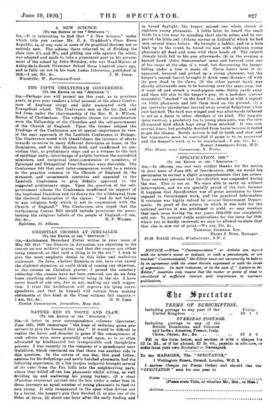NATURE RED IN TOOTU AND CLAW. [To TICE Roma or
me "Sescrerois."] Sta,—A. letter in your correspondence columns (Spectator, June 12th, 1920) eneouragei "the hope of inducing game pre- servers to give the buzzard fair play." It would be difficult to realize the havoc and disaster to game if the consequences of such advice were more generally acted upon, as is so often Advocated by kindhearted but irresponsible and thoughtless persons. I was recently in the coinPanY Of a gamekeeper near Guildford, which convinced me that there was another side to this question. In the course of one day, this good fellow, anxious for his fledgelings and newly-hatched pheasants, had the following experience, (1) a fox (vutpes vulgaris) brought several of its cubs from the Fox hills into the neighbouring park, where they killed off ten hen pheasants whilst sitting, as well dividing up and scattering his PRIM turkeys, (2) a stoat (Putolius ermineus) carried into its lair under a cedar tree in three journeys an equal number of young pheasants to feed its own young. It only re-appeared in the open when driven out by a ferret, the keeper's gun then finished it, as also one of its
• litter of three, (3) about one hour after the early feeding and
in broad daylight, the keeper missed one whole clutch of eighteen young pheasants. A little later he heard the small birds in a tree near by sounding their alarm notes, and he sus- pected the little owl (Athens noctua or Lilford's) which he had seen several times before. He brought a ladder, and in a hole high up in the trunk he found its nest with eighteen young pheasants all dead and some with their heads off. The culprit (female bird) fell to his gun afterwards, (4) in the evening a kestrel hawk (faleo tinnumeelus) came and hovered over one of his coops at the edge of a wood, but discovering the keeper hiding under a tree it made off. Three hours later it re- appeared, hovered and picked up a young pheasant, but the keeper's second barrel brought it down some distance off with its prey dead in its claws, (5) the other parent hawk was shortly afterwards seen to be hovering over the same coop, but it went off and struck a wood-pigeon some thirty yards away and then fell also to the keeper's gun, (6) a jack-claw (corms monadula) "stocked" on the head (i.e., struck at with a rapier) six little pheasants and left them dead on the ground, (7) a jay (garrulus glandarius) carried away several fledgelings .hen just hatched. The bird was winged and was afterwards tethered to act as a decoy to other offenders of its kind. The mag-pie (pica rustica), a predatory foe to young pheasants, was the only ill-reputed bird which kept away from mischief. It was seen several times, but probably desisted from harm because it failed to get the chance. Surely nature is red in tooth and claw and her transports must be controlled if game is to be preserved and the keeper's work is to be maintained.—I am, Sir, &e ,
ROBERT ARMSTRONG-JONES, M.D.
Plds Dinas, near Carnarvon, N. Wales.






































 Previous page
Previous page